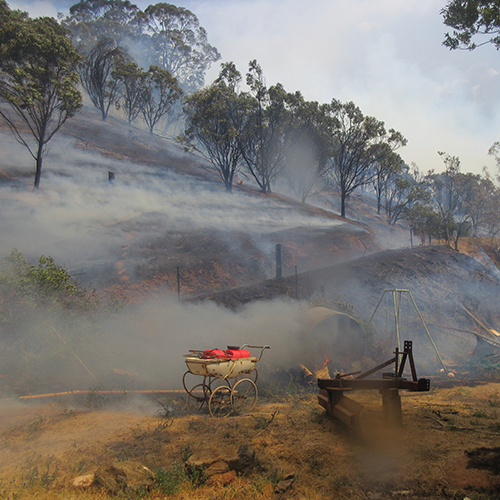28 January 2020
F or the past 30 years, University of South Australia ecologist Joan Gibbs has nurtured 70 acres of semi-natural bushland in Cudlee Creek, which she and her partner Terry Reardon call home.
or the past 30 years, University of South Australia ecologist Joan Gibbs has nurtured 70 acres of semi-natural bushland in Cudlee Creek, which she and her partner Terry Reardon call home.
When fire tore through their property on Friday 20 December, it took just 15 minutes to reduce the landscape to ashes, leaving only their house standing.
Four weeks on, the devastation is plain to see, but so too are the first signs of recovery. Green shoots are sprouting from blackened tree stumps, native and exotic grasses are starting to spring back, and recent rainfall has purged the pervasive smell of ash and sweetened the air.
The charred landscape remains an eyesore but also presents an opportunity to start from a clean slate and ensure the native flora gains the upper hand, outsmarting invasive weeds, grasses and other exotic species in the regeneration process.
“The community response has been outstanding,” says Joan, “and the first thing we need to do is mobilise volunteers to help source and spread native seeds over the affected landscape before exotics take hold.”
“The blackness that people can see is actually a very rich source of carbohydrates that provides a substrate for growing fungi. This may be the way in which we can get the right connections happening – between the fungi, the biochar, the bacteria and the native plants – to kickstart the ecosystem.”
The bracken and blackberry have also started regenerating and while the latter chokes native plants, it also provides cover for wildlife, Joan says. “The thing that people can do is to choose places to spread native seeds where the blackberry will not dominate”.
The best way to fast track the bush recovery is by planting tube stock or transplanting in areas where there are abundant native species, smothering the exotics. But it’s more complex than gardening and will require the input of scientists with specialised knowledge.
“Growing an artificial native forest is difficult, especially the ground layer because that is where 90 per cent of the biodiversity is. It requires a lot of ecological thinking, knowing which seeds to source and what they need to germinate.
“If we can marry the community’s goodwill and enthusiasm with a coordinated recovery effort, we have an excellent chance of laying the right foundations for our ecosystem,” Joan says.
A video interview with Joan Gibbs is available at https://www.youtube.com/watch?v=TsCv0uC3uDI
Caption: Joan Gibbs' property at Cudlee Creek, the day after fires devastated all 70 acres, leaving only the house standing.
Media contact: Candy Gibson office +61 8 8302 0961 mobile: +61 434 605 142
email: candy.gibson@unisa.edu.au Researcher: Joan Gibbs home: 83892358 mobile: 0414 304 875




